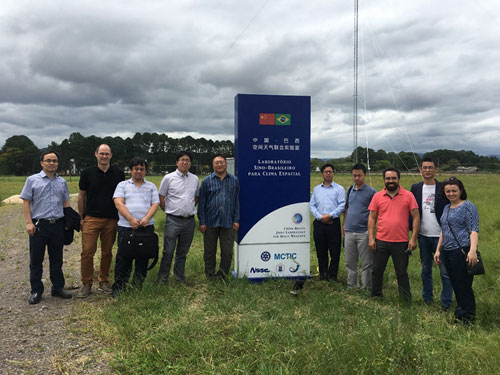[China Instrument Network Instrument R&D] On December 5, the China-Brazil Space Weather Cooperative Laboratory / South American Space Weather Laboratory of the Chinese Academy of Sciences (referred to as the South American Laboratory) held a South American laboratory monitoring equipment technology acceptance and postdoctoral fellowship in Santa Maria, Brazil. Assessment review meeting. From the National Space Science Center of the Chinese Academy of Sciences (NSSC), the Shandong University (SDU), the National Institute of Space Research (INPE) of Brazil and the National Center for Space Research's Santa Maria South Center (CRS/INPE), relevant leaders and experts attended the meeting.
South American laboratory Santa Maria ionospheric digital altimeter scene.
In the first phase of the South American laboratory, there were four sets of space environmental monitoring equipment for monitoring the ionosphere and the upper atmosphere, including the sodium-potassium dual-wavelength laser radar at the INPE headquarters campus and the ionospheric digital altimeter at Santa Maria, Brazil. Layer GPS-TEC with scintillation monitor and fluxgate magnetometer. The review meeting was the acceptance of the system functions and performance indicators of Santa Maria monitoring equipment. Xu Jiyao, a national key laboratory of space weather science, served as the head of the expert group and chaired the meeting.
The expert group carefully listened to the technical acceptance report of the project team, reviewed the test report, checked the function, performance, operating status and data transmission of all monitoring equipments on site and conducted inquiries on key technical issues. After testing and auditing, the expert group believes that the functions and performance indicators of the three sets of monitoring equipment systems completed by the project team meet the requirements of the construction task book. The system is stable in operation and can obtain data such as the ionospheric frequency diagram and drift. Ionospheric TEC , The scintillation index, satellite signals of the Beidou, Galileo, GLONASS and other four major navigation and positioning systems; and geomagnetic three-component data, all agreed to pass technical acceptance. This indicates that the first-phase monitoring equipment of South American laboratories has been transferred to formal scientific operation through acceptance, and has laid a solid foundation for the acceptance of the first-phase construction tasks of South American laboratories in mid 2018.
The ionosphere at low and mid-latitudes is a special geographical location in the ionospheric equatorial anomaly zone. It is a high incidence region of ionospheric scintillation and the equatorial hump. Therefore, it has become a key area of ​​ionosphere research. The geographic advantages of China and Brazil, which are symmetrically conjugated at the middle and low latitudes (180 degrees in longitude, and the latitudinal symmetry between the north and south of the equator) have important scientific implications for conducting space weather comparison studies and 24 hours of uninterrupted solar monitoring. The ionospheric and mid-to-upper atmosphere monitoring equipment constructed by the South American laboratory in the first phase provided indispensable data for scientists to study the spatial weather changes at low and mid-latitudes. In the future, the second phase of the South American laboratory will take into consideration the combination of the chain network and the extension of the new layout principles, based on Brazil, expanding in South America, and making new contributions to the research and development of China's space science.
(Original Title: China-Brazil space weather joint laboratory monitoring equipment successfully passed the technical acceptance review)
3D printing is a type of rapid prototype technology, also known as additive manufacturing.
Its design process is: firstly to use computer modeling software to model, and then "partition" the built 3D model into layer-by-layer sections, the printer reads the cross-section information from the file, and to use materials (liquid, powder or flake) to print these sections layer by layer, and to bond the layers together in various ways to create a solid body.
The characteristic of this technology is that it could create almost any shape of the article, it is in common used to make models in the fields of mold manufacturing and industrial design, and then gradually used in the direct manufacturing of some products. The technology has applied in jewelry, footwear, industrial design, architecture, engineering and construction (AEC), automotive, aerospace, dental and medical industries, education, geographic information systems, civil engineering, firearms, and some other fields.
Common materials for 3D printing include nylon glass fiber, durable nylon material, gypsum material, aluminum material, titanium alloy, stainless steel, silver-plated, gold-plated, and rubber-like materials.3D Printing Services
3D Printing Service,3D Printing Metal,3D Printing Models,3D Printing Materials
Guangdong Shunde Teamwork Model Technology Co., Ltd , https://www.gdtwmx.com
